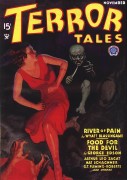 John Newton Howitt studied at the Art Students League with George Bridgman and Walter Clark. A devoted landscape painter, his work was sold at fine art galleries in New York City. In 1905 he began to freelance for The New York Herald Tribune, This Week, and other publications. His later markets included Red Book, Woman’s Home Companion, Maclean’s, and Scribner’s. Following the First World War, Howitt’s work could be found in Country Gentleman, Farm Life, Liberty, and The Saturday Evening Post.
John Newton Howitt studied at the Art Students League with George Bridgman and Walter Clark. A devoted landscape painter, his work was sold at fine art galleries in New York City. In 1905 he began to freelance for The New York Herald Tribune, This Week, and other publications. His later markets included Red Book, Woman’s Home Companion, Maclean’s, and Scribner’s. Following the First World War, Howitt’s work could be found in Country Gentleman, Farm Life, Liberty, and The Saturday Evening Post.
The Great Depression vastly diminished the markets to which Howitt had been selling. Needing an income, he turned to the pulps. An excellent painter, Howitt found a ready market in the rough-paper periodicals, selling freelance pulp covers to Adventure, Dime Detective, Dime Mystery, Horror Stories, Love Story, Secret Service Operator #5, The Spider, Terror Tales, Top-Notch, The Whisperer, and Western Story. Although he signed his covers for the western, adventure, and romance pulps with his professional signature, his work for the hero and weird-menace pulps was signed with only his initial, “H.”
Although John Newton Howitt’s iconic cover images for Terror Tales, Horror Stories, The Spider, and Operator #5 are among the most disturbing in the history of pulp art, his painting technique is among the most dignified of all the pulp artists. On Saturday, August 9th, at 8:30 PM, please join art historian David Saunders for an exploration of “The Mystery and Mastery of John Newton Howitt” at PulpFest 2014.
Born in 1954, David Saunders is a New York artist. His work has been exhibited worldwide in museums and corporate and private collections, including the Museum of Modern Art, The Metropolitan Museum of Art, The Brooklyn Museum of Art, and the Hirschhorn Museum of Art in Washington, DC. He has taught art at colleges nationwide, including Yale, Oberlin, R.I.S.D., S.C.A.D., Middlebury, Washington University, as well as art schools in France, Korea, Mexico and Japan.
David’s father was the legendary illustrator, Norman Saunders. His mother, Ellene Politis Saunders, worked at Fawcett Publications as Chief Executive Editor of Woman’s Day Magazine. In 1972, David became his father’s business and correspondence secretary, which started a long project to catalog his father’s 7,000 published illustrations. He spent the next seventeen years gathering published examples of his father’s work from used bookshops and submitting each new entry to his father’s inspection. What began as a sentimental hobby for a father and son grew into an impressive archive of 20th century American illustration. After his father’s death in 1989, he continued to complete the archive on his own. He interviewed his father’s surviving associates to record their oral histories. These transcripts helped to broaden his viewpoint of the popular culture publishing industry and also recorded vital information about the lives of other historic illustrators. Some of this material has been published as biographical profiles of classic illustrators in Illustration Magazine and a number of book-length biographies and appreciations of pulp artists.
David Saunders is the foremost scholar of American pulp illustrators. His free public website, Field Guide to Wild American Pulp Artists, has over three-hundred biographical profiles of these creators of popular culture. David continues to research, document, and promote a greater appreciation of pulp artists. To find out more, please visit pulpartists.com, davidsaunders.biz, normansaunders.com, and the illustratedpress.com.
To learn more about the image used in this post, click on the illustration.







